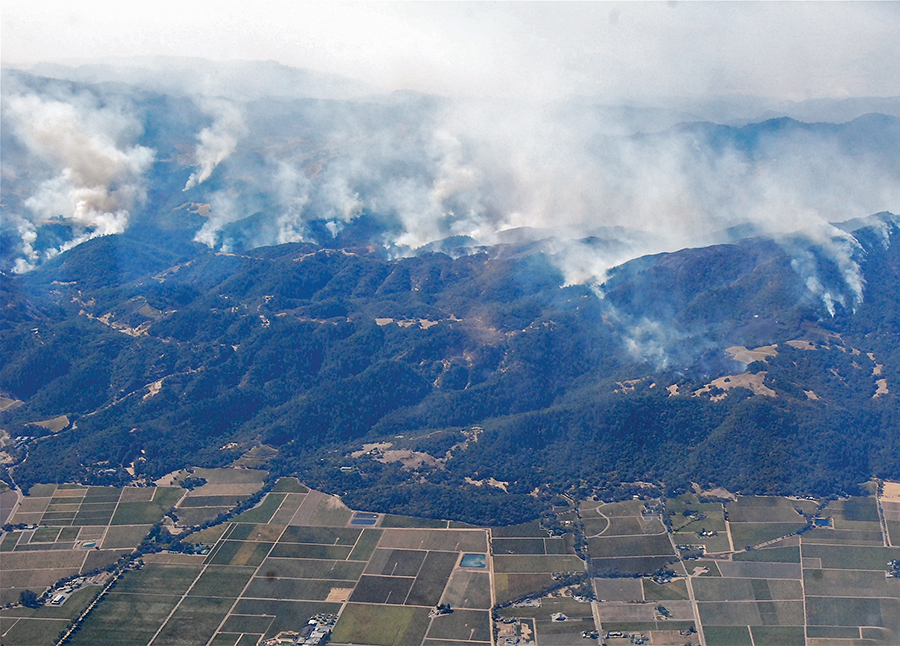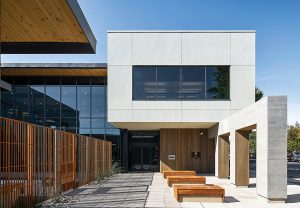
An aerial view of wildfires in Sonoma County on October 14, 2017. Photo by Army National Guard Capt. Will Martin/Flickr.
Where there’s smoke, there’s fire, goes the old saying — and Northern California has learned that where there are wildfires, there is smoke, sometimes blankets of irritating, unhealthy smoke. A recent study in the journal Nature Communications concluded that tiny particles in wildfire smoke are up to 10 times as hazardous to human health as similar particles from other sources. In addition to smoke, wildfires have economic and human impacts, and also add massive carbon emissions to the atmosphere, exacerbating climate change in a vicious cycle which may lead to additional wildfires. In our efforts to dampen their size and frequency, reducing the fuel they depend on is proving increasingly critical.
Although wildfires that devastate developed areas also burn structures and possessions, vegetation and trees are their primary fuel; this is why a key strategy in stopping wildfires is to create “defensible space” by clearing vegetation around homes or establishing firebreaks in wooded areas. Removing “biomass” — living and dead trees and underbrush — is therefore a focal point of wildfire prevention and suppression. Handling that biomass is a challenge; burning it adds to carbon emissions, while other options may leave it as fuel for future fires.
Another problematic category of biomass related to wildfires is “salvage trees,” trees killed by fire that need to be removed for safety or fuel reduction. Fred Euphrat, a retired forester now teaching at Santa Rosa Junior College, owns 400 acres that were impacted by fire, and he is now selling fire-damaged trees to the county’s remaining lumber mill. Marketability of salvage timber is limited by how quickly it can be harvested, as well as how easy it is to cut and transport. Euphrat quoted a timber industry motto, “Every time you move a piece of wood you double its price.” Even chipping is a problem, depending on the location and condition of the logs.
Currently, there are a few basic ways to remove biomass from potential wildfire locations. You can clear undergrowth while leaving trees (a “shaded firebreak”), you can totally clear both trees and brush, or you can selectively thin out the trees. However, cutting and clearing simply leave biomass in a different form: logs and slash (limbs, treetops, and other woody debris). Although logs may be removed and sold, slash and brush have no value. As Northern Sonoma County Air Pollution Control District Executive Officer Robert Bamford put it, “How do you get rid of all this stuff?”
In the 1980s, a number of bio-energy plants were permitted to burn biomass to create energy. As energy alternatives evolved, these plants became uneconomical; they were also opposed by environmental groups, which maintained that their emissions created pollution and greenhouse gases. Today there are only a few remaining in the state.
In urban areas, biomass from clearing and thinning is often turned into landscaping wood chips, which break down faster but also release their carbon more quickly as they decompose. In more rural areas, mills may produce chips for bio-energy or paper, but chipping is often not economical because of the difficulty and expense of transporting the material from remote locations to a chipper.
Leaving woody debris to decay naturally sequesters the carbon, but flammable material remains on the forest floor. The most common method of dealing with forest waste from clearing and thinning is still to create multiple slash piles in open areas. These are then burned when air pollution regulations permit, resulting in local smoke impacts and the release of as much carbon as if they had burned in a wildfire. “Slash piles are traditional,” the U.S. Forest Service’s Debbie Page-Dumroese told a recent Redwood Forest Foundation Initiative workshop, “but the smoke and particulates have become untenable — we have to do better.”
Controlled or prescribed burning — deliberately setting fires in a specified area under carefully monitored conditions — can also thin and clear vegetation by removing the lighter fuels that will burn quickly, while sparing the larger trees from prolonged heat which would kill them. This practice was used for centuries by Native American tribes to manage forested areas, and tribes are now taking a significant role in its revival by modern forestry.
Prescribed burns have their own drawbacks. They must be done under permits that strictly specify conditions; they may be cancelled if the weather isn’t right, and they create smoke which may affect air quality unless humidity brings particulates down to earth quickly. In addition, the condition of many forested areas makes controlled burns dangerously unpredictable without prior programs of manually thinning and clearing, because years of fire suppression have overloaded these areas with flammable biomass. “Prescribed burns are not possible in overgrown forests,” said Clarke Stevenson of the firm California Law Empowering Renewable Energy. He asserted that “fires are crucial to long-term forest management, but they can’t be done now.”
To confront the challenges of handling biomass, policymakers and land managers are exploring new options. In one intriguing example, North Bay entrepreneurs may help develop innovative methods through the Sonoma BioBiz competition, sponsored by the Northern Sonoma County Air Pollution Control District, in partnership with the Bay Area Air Quality Management District, CalFire, and many local agencies and organizations. The broad coalition of sponsors indicates the range of interest; in addition to air quality impacts, major county industries are affected by loss of timber and smoke-tainted wine grapes, while fire damage and destruction of viewsheds can affect property values.
Competition organizers are not expecting a proposal for a bio-energy plant that simply burns wood chips to create energy. Their website provides some starter ideas: several types of controlled combustion to create synthetic fuels and biochar; “mass lumber” for construction projects; and using wood from salvage trees.
Controlled combustion processes include pyrolysis, gasification, and biochar production. Pyrolysis and gasification capture the gases created as the biomass burns to create a synthetic bio-oil or syngas that can be burned for heat or energy. Both release less carbon and emit fewer pollutants than open burning or bio-energy plants.
Biochar kilns use the gases that are emitted during combustion as additional fuel in a low-oxygen combustion process. Biochar has a number of commercial applications when produced in bulk, or smaller quantities can be returned to the forest floor, as charred wood from a forest fire would be. It captures up to 50 percent of the carbon from biomass, making it an excellent way to sequester carbon long-term.
Unlike larger facilities that require the biomass be transported to them, biochar kilns come in a variety of sizes suitable for smaller-scale operations closer to the biomass source. A truck-mounted biochar kiln is currently operating on the Richardson Ranch in northwestern Sonoma County. A recent virtual workshop hosted by the Redwood Forest Foundation Initiative showed how portable kilns are being used in Mendocino County to create biochar from biomass generated from firebreaks and stream restoration projects. The workshop also showcased a grant-funded demonstration project conducted by the Sonoma County Ecology Center that uses similar kilns. The Ecology Center’s project manager Raymond Baltar predicted during the workshop, “Burning low-value biomass in the forest will continue.”

The Brentwood Public Library is one of several Bay Area construction projects to use mass lumber, which is cost-effective and has a low carbon footprint. Photo courtesy Contra Costa County Library.
Other more novel uses for biomass include mass lumber, which is growing in popularity as a construction option. These laminated wood products are being used in Bay Area projects, including the Brentwood Public Library and the Microsoft campus expansion in Silicon Valley. California recently amended building codes to allow buildings of up to 18 stories to be built using mass lumber rather than requiring steel and concrete, significantly reducing their cost and carbon footprints. An affordable housing project in San Jose using mass lumber will start construction in 2022.
Wood from fire-damaged trees may require special processing, but is now being used by cabinet makers and musical instrument builders. Both mass lumber and salvaged wood products lock up carbon because the wood is not being burned or otherwise destroyed.
An informal survey of landscapers and tree-trimmers in 2013 in Sonoma County indicated that much of their waste material went to landfills, sequestering the carbon, but it could be diverted to other biomass uses. Fire prevention activities such as clearing defensible space around homes in the wildland-urban interface, or clearing trees away from power lines, also create woody biomass. Much of the agricultural waste generated by vineyards is potential fuel for biochar or other biomass combustion.
Better biomass management can transform woody waste material from a headache into an asset. In addition to avoiding wildfires and preventing smoke and carbon emissions, innovative approaches to biomass as a resource may play a significant role in a more resilient region.
Leslie Stewart covers air quality and energy for the Monitor.

